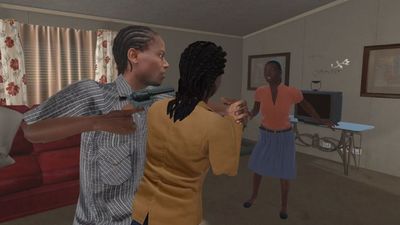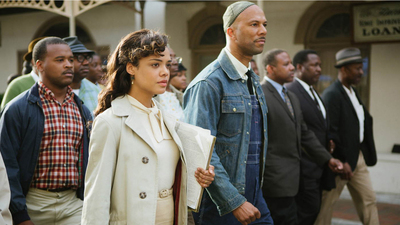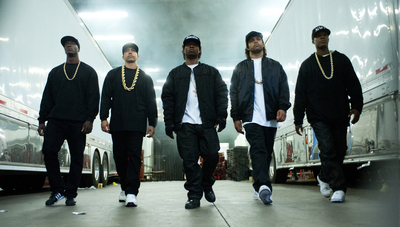
BY MELINA GILLS |
HARD WORLD FOR SMALL THINGS Creator Janicza Bravo Tackles Police Brutality Through VR
A bright star on the indie cinema map, Janicza Bravo spoke to Tribeca Film about her venture into virtual reality with HARD WORLD FOR SMALL THINGS, which will have its New York premiere at the 2016 Tribeca Festival Hub.

Virtual Reality is quickly expanding the world of dramatic storytelling, and the Tribeca Film Festival is contributing to that transforming landscape with its vast and diverse VR offerings. A highlight of Tribeca 2016's Virtual Arcade is the fiction short Hard World for Small Things, directed by Janicza Bravo. Born in New York, raised in Panama, and now residing in Los Angeles, Bravo has been making innovative and engaging independent cinema since 2011, beginning with the Vice-produced short Eat! (embedded below). The viciously funny film debut stars Katherine Waterston (who has since become an indie darling with Inherent Vice and Queen of Earth) and Brett Gelman (a familiar face in comedy who's also Bravo's husband).
After her Michael Cera-led short Gregory Go Boom (embedded below) won the Grand Jury Prize at the 2014 Sundance Film Festival, Bravo was named one of Filmmaker Magazine’s "25 New Faces of Independent Cinema." With a background in theater, which she studied at New York University, Bravo fearlessly embraces new forms, genres, and technologies.
Hard World for Small Things, which premiered earlier this year at Sundance, is Bravo's first turn to virtual reality. The live-action short offers viewers a backseat to what appears to be an average ride among friends to a neighborhood deli but becomes a shocking look at police violence in Los Angeles. Bravo was approached to make her first VR film by Seed&Spark, which has teamed up with WEVR to fund projects with the aim of creating more diversity in VR storytelling. The film brings to life the sounds, humor, and warmth surrounding the young life of a man (played by Keith Stanfield, who's also in the US Narrative Competition world premiere Live Cargo) who falls victim to the deeply embedded injustices plaguing U.S. institutions, chief among them the police force. Challenging the indifferent dismissal and dehumanizing that often takes place regarding the lives of "minorities," or non-white people, Hard World for Small Things uses virtual reality to bring the viewer into closer, more intimate contact with these habitually voiceless and faceless bodies.
Hard World for Small Things will be shown inside the Tribeca Festival Hub from April 18-20. (Buy tickets here.) The eloquent, bright Bravo recently spoke with TribecaFilm.com about breaking into virtual reality, working in an industry that's painfully monochromatic, and exciting new horizons.
You've said that, at first, you were hesitant to work in VR. What finally sold you?
I was still hesitant even after I said yes. I think the selling point for me, as my big entry into it, is that it is rare as an artist to get invited to make the things you want to make. So why would I say no to the possibility of exploring something new and the opportunity to make something that was mine? But I was still kind of hesitant about the medium.
What negative ideas did you hold about VR prior to this project and how have these ideas been changed?
It wasn't so much negative… I come from theater, which is my home base, and VR sounds very far from that. In my first experiences watching VR—it was not what I would choose to watch. It’s curious to make work in a medium I wasn’t seeking out. I wasn’t sure who the audience was, and I wasn't sure if that audience was my audience.
I unfortunately was only able to see the film once, but I immediately wanted to watch it again when it was finished. With film, that can happen sometimes but not so often. Is your intention that viewers experience your project multiple times because of the varied experiences that are possible with it?
Yeah, I hadn't really thought about it exactly like that, that when you go to the movie theater, it's rare that you see something so excellent that you want to watch it again. There are only a handful of films I want to revisit. With VR, when I was coming up with the story I would tell and how it would unfold, something that was important to me was how you revisit the space. If you create enough Easter eggs, then the audience has something to come back to and can follow separate journeys. If you watched it again, you would be able to see something else. You could focus on a different point, because each actor is going through his or her own journey.
I was very drawn to the meticulous sound design on your films and loved the horror elements in Gregory Go Boom and Eat! What was your vision for the sound design in this film, and how was that affected by it being in VR? I felt that when turning my head and looking at one person, I could hear them more clearly.
Sound is very important to me. Music is very important to me and tends to feel like another character in the piece. It is an exaggeration of where the people are at emotionally. The whole point was to create something that felt a little docu-narrative, so using tonal music just didn't make sense. Working with my composer [Heather Christian], who I've worked with on everything I've made, and sound designer, we were talking about living in something that feels natural but that also has exaggerated elements that are theatrical.
On video gaming platforms, you have "positional sound." So if you look to the left, that becomes amplified; and what is away from your ear becomes quieter. In film, you can do a version of that by amplifying what you want the audience to hear, but this is very exciting because you’re essentially dropped into an event. So if the audience wants to focus on the two women on the sidewalk, they can hear them more loudly than the woman sitting in the car. And the music was all very diegetic. I didn’t want to add anything. It would feel false to add anything, because the starting point for this for me was for the audience to feel that they were invited into something special and that they would not usually get a front row seat to. It should have the texture and quality of life.
Did your experience with theater inform your work on this VR project, which is in some ways closer to theater than cinema, given that the viewer has more freedom deciding where to look?
It totally did. I went from feeling that it was so alien and far to feeling that it was closer than I thought. I started to feel like directing theater with a camera, like theater in the round. You start to get the feeling that you're the actor on the stage. You feel like one of the performers in the piece. I directed it that way. When you call action, it feels like the opening night of a play every time. The director cannot stay on the stage. On a traditional film set, there’s a camera and monitors and the director hangs out in one corner of the room while the performance happens. With VR and the way its cameras work, you call action and then you’re hiding in a hole somewhere and the actors have full control of the world. You really are handing the world to them, and you’re crossing your fingers and saying, "Good luck. This is point A and this is point B, so see you at the end of it." When you're working with a play, you have lengthy rehearsals, then it opens and the play no longer belongs to the director, it belongs to the actors.
Your shorts have been dark comedies that follow lonely people seeking connections in unconventional, even violent ways. While there are certain connections between those and Hard World, there's a strong thematic departure. What were the main motivations behind telling this story now?
I was trying to figure out what kind of story would make sense for the space. It felt uncomfortable to be inside my kind of film, not uncomfortable in a cool way but in a "Why is this happening?" way. I dropped doing a dark comedy, and I didn't set out to write a certain thing. I asked myself, "What is the story that I'd want to be in this space?" I watched Chris Milk's TED talk on empathy. That was playing a big part in my brain.
A lot of men were being shot at last year, and I remember my own engagement with this story. My cousin had been shot by the cops in the summer of '99 in Brooklyn. I looked him up for the first time last year since it had happened. I found a couple paragraphs in the Post and Daily News. They were both about the event: a mistaken identity and asphyxiation by the cops. It was wildly disturbing, because he had been on vacation from Panama, which is where I am from. He had lived this whole, full life, and it had been reduced to this event that was about where he was looking, or not looking and not understanding, and a bag of coke. That you could be reduced to a single paragraph that had nothing to do with your life, was disturbing to me.
What if their lives were more than a couple of paragraphs; what if it was their friends, where they were going, what they had read, what they had desired, etc. I wanted to make a short piece that was emotionally longer than a paragraph, and that you got a slice of his life before he died. So when he died, it’s not about the event and what he did to have died; it becomes about who he was, his humor, his laugh, these things.
This reminds me of Ousmane Sembene's film Black Girl. One of the tragedies is that she's reduced to a paragraph in a newspaper that cares nothing about her, her life, or who she is. It's a very powerful image.
So, essentially that—what you just described. Here is this full life, and we cannot stop how it ended terribly, but we can give more contexts to these people. When I was reading these stories, it was all about this event and who shot them and why they shot them. The cops had these full lives, but these men and these women didn’t, and it didn't make sense. Obviously: deep racism and shit like that. I understand why, but I would like for that not to be the case.

Do you think film, and art in general, can and/or should play an important role in changing police behavior and the systemic racism in U.S. institutions?
Yes, but it's kind of a funny question for me to answer because most of my work is not about these types of events but rather loneliness and isolation. This is really my first time venture to make something pointedly about politics and race. I do think art should be about that, but I also think that artists should be making the kind of work that they're trying to work through. My universal themes that I am attracted are not generally those.
Look, that's a part of my life. I've lived as a woman of color in the arts, and I am dealing with this shit constantly. Maybe I'm not doing work about it because it's what I'm working through in my life. I do think that everyone should be trying to make work like this but also making the work about where they're at. It's hard to say, because art is so much about the individual and what they are interested in dissecting and saying, so I cannot say that people should be doing this.
What art or film projects have you recently experienced that you see as powerful in helping to bring necessary social changes and challenge the status quo of racially charged police violence?
No, I have not seen anything. For me, this is a very big conversation. When I think of my contemporary filmmakers, most of the work they're making doesn't address this or even feature any non-white actors. Film is inherently white and male. When I was working on costumes, I would be the only person on the set who was a person of color. I'm talking about a set of anywhere from 50 to 200 people. It starts behind the scenes as well. The question of diversity is a question of who is putting the work together. It's a much larger conversation, and it's about making changes behind as well as in front of the camera. Who's doing the casting? Who's the producer? This isn't an attack on white directors; I'm not into that, but… You go to a festival like SXSW, Sundance, or Tribeca, and you find most of the filmmakers are white.
I even see it in myself, trying to be more inclusive in my work. I've been on the set where I'm the only person who is black. It's incredibly challenging. It's important for me to look around the room and see it the way I see the world, which is in multiple shades.
Intrigued by virtual reality? Click here to learn about all of the VR and innovation projects that will be at the 2016 Tribeca Film Festival, taking place April 13-24.


